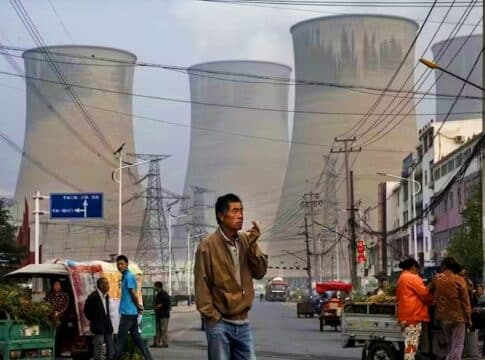China’s CO2 Emissions Up 4% in Q1 2023, Hit a Record High
China’s carbon dioxide (CO2) emissions grew 4% in the first quarter of 2023, hitting a record high and is projected to reach an all-time high this year. But the continued expansion of low-carbon energy will bring down the country’s emissions eventually.
The new analysis according to Carbon Brief shows that the rapid expansion in low-carbon energy can make the emissions to peak and decline if the post-Covid recovery plan works out.
With China focusing on economic growth, the biggest CO2 emitter in the world’s footprint will likely to hit an all-time high in 2023. The country emitted over 10,000 million tonnes of CO2 in 2020, representing about 30% of the world’s carbon emissions.
China’s Quarterly Carbon Emissions
Compared with a year earlier, China’s carbon emissions jump 4% in this year’s 1st quarter, according to the analysis. It exceeded the previous peak in emissions in the same quarter in 2021.
Emissions are estimates from China’s National Bureau of Statistics data on production of fossil fuels and cement, China Customs data on imports and exports, and WIND Information data on changes in inventories.
As seen in the chart above, the red bar represents China’s carbon emissions for the first quarter of each year. The rise was due to the growing demand for fossil fuels, with increases in oil consumption (over 5%), coal (more than 3%), gas (over 4%), and cement production (4%).
What Causes China’s Emissions to Rise?
The key reasons for the super-emitter’s increase in carbon emissions are the following, the analysis reveals:
Economic rebound post-Covid recovery
Financial stimulus measures
Weak hydropower generation
Breaking down the emissions per sector, the biggest contributor to the increase was power generation, where coal-generated electricity grew by 2%. The coal-power output rose by 3.6% relative to the previous year’s quarter.
Source: Carbon Brief
The poor hydropower production in China resulted in increased coal power use. Low rainfall and droughts caused the weak hydro output.
The world’s second largest economy by GDP has been boosting its domestic coal power production since 2021 for energy security. It rose by 11% in 2022 but despite more domestic supply, coal import almost doubled in Q1 2023.
The reason for that is the lower quality of coal produced in the country – each tonne containing less energy.
In terms of electricity, demand grew by over 4% which accounts for about 80% of China’s total carbon emissions increase. This was largely due to the end of the country’s zero-Covid policy, meaning businesses and commercial operations resumed.
For the same reason, transportation activities got back to normal, increasing the consumption of fossil fuels by more than 6%. Air travel rebounded intensely, in particular.
China Achieves Significant Energy Milestone
Despite increases in CO2 emissions, China managed to hit a meaningful milestone in generating power from clean or non-fossil sources. These include renewables and nuclear which exceeded 50% of the country’s installed power capacity in history. They overtook coal production capacity and other dirty sources of power.
In particular, solar and wind power installation increased significantly both hitting a record high.
Solar installations grew by almost 3x the previous high of 13GW in the same quarter of 2022 – 34 GW. New wind power installations – 10.4GW – increased by 32%, another record for Q1 2023. The country beats its new wind and solar capacity 120GW target in 2022, achieving 125GW.
A key element in China’s strategy to ramp up its wind and solar power generation is developing massive clean energy bases in its deserts, abandoned coal mines, and other unused lands.
Those bases are being built in batches, the first two with 97GW and 200GW capacity will be completed by 2025. If installations in 2023 hit the country’s 160GW goal, 240GW annual capacity will be added in the next two years.
China’s nuclear capacity also improved.
Based on its current nuclear capacity (57GW) and ongoing construction (27GW), the super-emitter is on track to achieve its targets. That’s to have 30GW under construction and 70GW in operation by 2025. Two nuclear reactors have already begun construction and one started producing power this year.
Demand for electricity is likely to increase this year in China, which will also push coal power production higher. However, the growing low-carbon supplies or energy from clean sources will try to match the demand growth in coal.
Ultimately, when clean energy surpasses the annual increase in electricity demand, the power sector’s carbon emissions will peak.
What Do China’s Emissions Look Like in 2023?
The current trends in the 1st quarter and industry estimates suggest that the largest emitter’s footprint will rise this year. It will likely top the previous peak in 2021 as shown in the chart.
Source: Carbon Brief
The major reason for this outlook is the Chinese government’s pursuit of financial stimulus measures to bolster manufacturing capacity, energy production, and transport infrastructure.
While increases in emissions vary per sector, overall energy demand will be up 3% in 2023. Taking into account the projected increase in low-carbon energy production, a 1% to 4% increase in China’s CO2 emissions will follow as fossil fuels make up the difference.
A report from the World Bank said that China would need $17 trillion in investments to achieve its climate goals. These investments are in the power and transport sectors alone.
The super-emitter had rebooted its carbon scheme, the China Certified Emissions Reduction, early this year to reduce its carbon emissions. If the post-Covid recovery works as planned, a sustained expansion in clean energy production will drive emissions to peak and then eventually decline in the coming years.
The post China’s CO2 Emissions Up 4% in Q1 2023, Hit a Record High appeared first on Carbon Credits.



